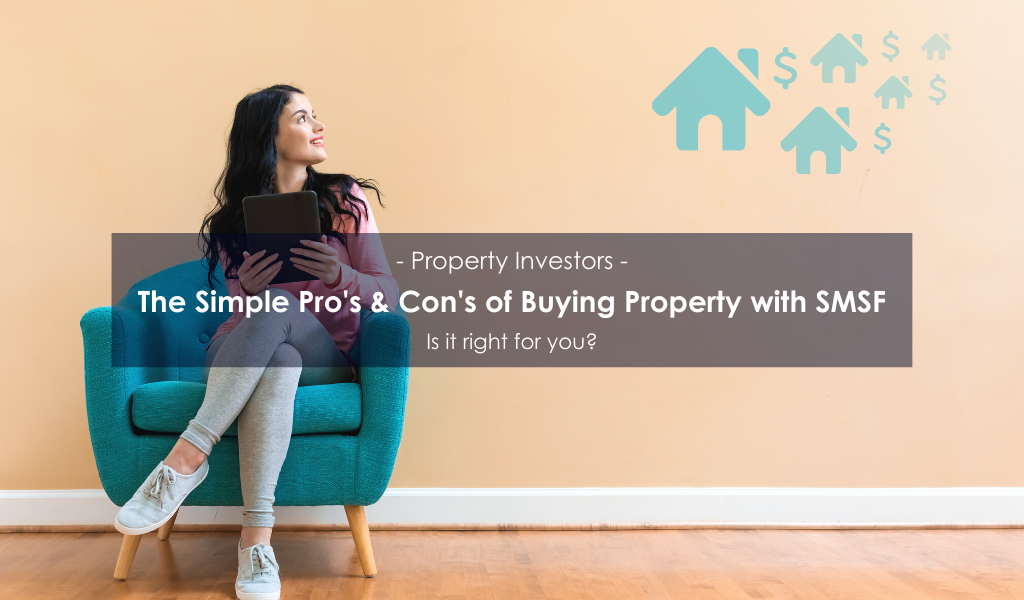
The Simple Pro’s & Con’s of Buying Property with SMSF – Is it right for you?
Find out if borrowing through a Self Managed Super Fund is right for you and your investment property portfolio.
A simple google search will quickly show an endless supply of ‘experts’ providing information on how to grow your wealth by buying property with SMSF, but is it really as good as they make out? Or is your superannuation just an untapped resource to sell properties directly from developers with big kick backs?
If you’re a visual learner and don’t want to read lots of text, skip to the table comparisons below for a brief snapshot.
If you want to know all the important details on the subject, just keep reading.
Attractions – Not Necessarily Pro’s
There is one main attraction to purchasing an investment property through a SMSF, and that is generally speaking a lower tax rate on both the profit each year and the eventual capital gains when sold.
A superannuation fund’s tax rate is 15%, so if your property has a net positive cash flow of $20,000 per annum, inside a SMSF you will only pay $3,000 in tax. However if it was purchased in your own name, it would depend on your marginal tax rate, but it could be between $6,900 – up to $9,400.
Tax savings on capital gains can also be significant with only 2/3rds of the capital gains inside a superannuation fund assessed and taxed at 15% – which essentially works out to paying 10% of the total capital gain. Whereas outside superannuation you will pay tax on 50% of capital gain at your marginal tax rate.
Another tax benefit relates to pension tax. Once you’ve converted your superannuation to a pension, no tax is applied on income or capital gains. So if you were to sell a property that has a significant capital gain, after you have converted your superannuation to a pension, then you can avoid capital gains tax all together.
It’s important to remember these tax advantages are that of superannuation in general and is available to all assets and not limited to just property investments inside a SMSF.
Possible Heavy Con’s
Depending on your strategy, some of the following negatives could really outweigh the positives.
For one, if the property is negatively geared – If the debt used to purchase the property is costing more in interest – this will result in lower tax benefit.
For example; If your property has rental income of $20,000 per annum, interest, depreciation and other expenses of $25,000, then that $5,000 shortfall only gets you a $750 tax benefit inside superannuation ($5,000 @ 15%). Whereas if it were in your own name, depending on your marginal tax rate, the benefit could be $1,725 – $2,350.
Another big factor to consider is the difference in interest rates. The interest rates are higher for a loan inside a SMSF as opposed to in your own name. The difference can vary based on a number of factors but is usually between 0.5% – 1.0% more expensive to borrow inside a SMSF than otherwise. An example; If you are borrowing $300,000, it could be costing you $1,500 – $3,000 more in borrowing costs inside a SMSF.
The final thing to consider and possibly the most important to your bottom dollar is the costs of running a SMSF. Ongoing book keeping and compliance responsibilities in being a trustee of your own SMSF are expensive. Keeping in mind that investing in property should be a long term play, so the expenses are ongoing.
Example Sum Up Of Expenses
Purchasing a $450,000 investment property with a $100,000 cash deposit (either available cash outside superannuation or available cash within a SMSF)
| Initial Costs | Purchase Directly | Purchase through a SMSF |
| Property Purchase Price | $450,000 | $450,000 |
| Stamp Duty and legals | $15,000 | $15,000 |
| SMSF Establishment | $0 | $1,500 |
| Total Initial Cost | $465,000 | $466,500 |
| Cash Contribution/Deposit | $100,000 | $100,000 |
| Loan Required | $365,000 | $366,600 |
| Sum of 10 year cash flows | Purchase Directly | Purchase through a SMSF |
| Rental Income | $268,255 | $268,255 |
| Property Management Fees | -$21,460 | -$21,460 |
| Rates/Insurance | -$22,928 | -$22,928 |
| SMSF Costs | -$0 | -$22,928 |
| Loan Interest | -$157,494 | -$189,980 |
| Net Cash Flow | $66,373 | $11,059 |
| Less Tax | -$22,899 | -$1,659 |
| After Tax Net Cash Flow | $43,474 | $9,400 |
Assumptions: Rent $450/week, 8% property management fee, rates and insurance $2,000 per annum, SMSF expenses $2,000 per annum. All expenses increasing at 3% per annum in line with inflation. Loan interest charged at 4.5% for non-super and 5.2% SMSF. Non-super tax rate of 34.5%. Net cash flow assumed to be directed or debited from loan balance. Assumes no claiming of depreciation.
| Capital Position after 10 years | Purchase Directly | Purchase through a SMSF |
| Property Value | $587,148 | $587,148 |
| Less Loan Balance | -$321,526 | -$355,600 |
| Net Equity | $265,622 | $231,548 |
| Possible Capital Gains Tax | $23,819 | $12,065 |
| Net Position after possible CGT | $241,803 | $219,483 |
CGT on non-super at 39% on discounted capital gain as a large capital gain would be likely to push individual into higher marginal tax rate. SMSF CGT calculated at 10% of capital gain. Property growth assumed to be 3% per annum.
This example shows that by adopting the same strategy to both purchase options, the financial benefits are in favour of purchasing outside of a SMSF due to cost of borrowings. Although circumstances can differ from person to person.
Borrowing Vs Not Borrowing
It is important to note the difference between buying a property within a SMSF without borrowing (or getting a loan) and buying one with borrowing.
When you borrow to purchase a property rather than just using the SMSF cash to do so, an entity called a ‘Bare Trust’ will be set up inside the SMSF to own the property. This means there will be restrictions on what you can actually do to the property when it’s under a borrowing arrangement. This is a very important factor to consider so make sure you know what you are allowed to do before you make this decision.
So, when weighing up these pros and cons, there is really no simple answer to this question other than – it completely depends on your circumstances.
The important thing is to not rush the decision. Never sign up at a high pressure property seminar! Make sure you’ve researched, calculated the costs, considered all the pro’s and con’s of each strategy and seek the advice of a quality financial adviser and accountant.
Written by Glenn Hilber of Precision Wealth Management | Edited by Aura Rental Management Marketing.
Glenn Hilber is a Certified Financial Planner with over 10 years’ experience and the owner of Precision Wealth Management.
This represents general information only. Before making any financial or investment decisions, we recommend you consult a financial planner to take into account your personal investment objectives, financial situation and individual needs.
Contact Glenn for further financial advice at glenn@precisionwm.com.au.
Estimate your SMSF Property Loan Repayments using this online Calculator


Comments